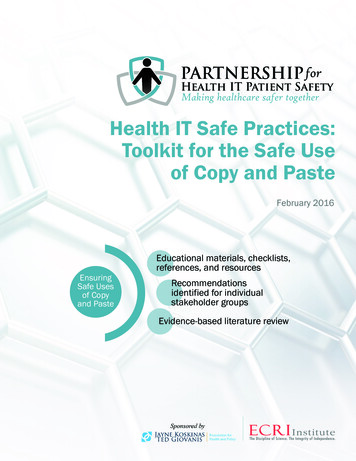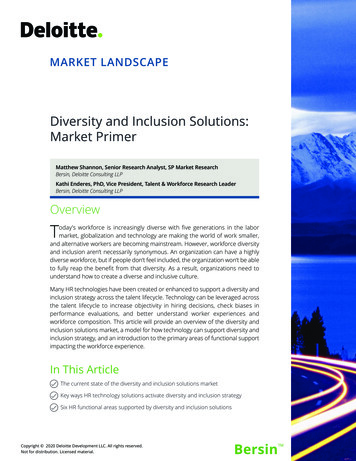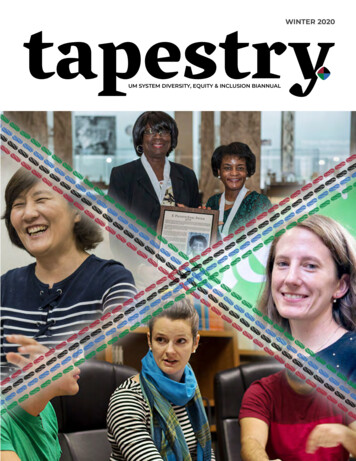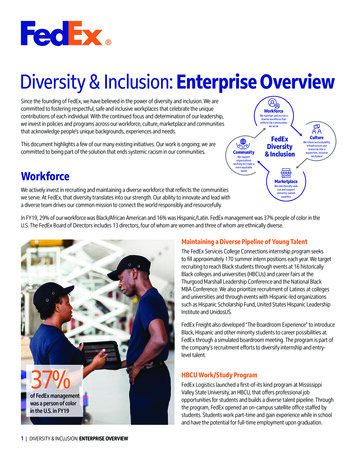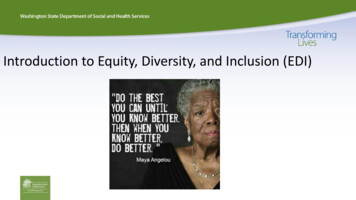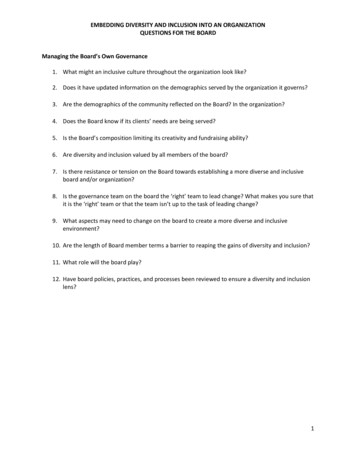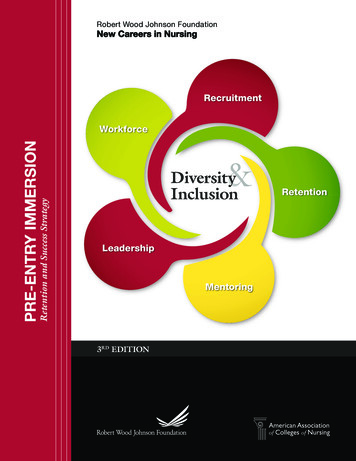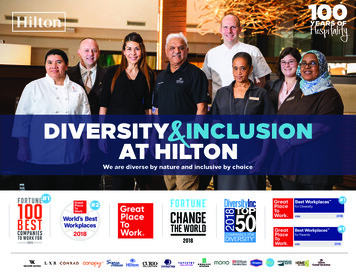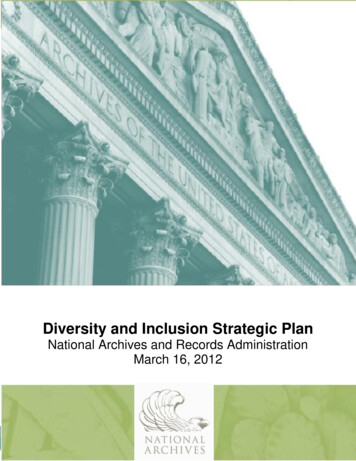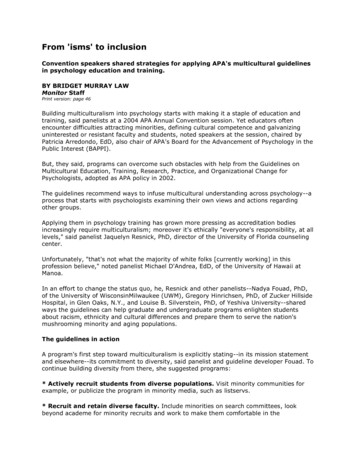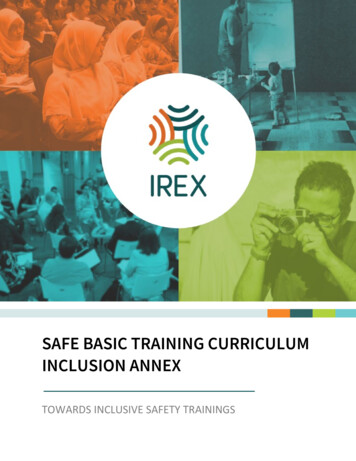
Transcription
SAFE BASIC TRAINING CURRICULUMINCLUSION ANNEXTOWARDS INCLUSIVE SAFETY TRAININGS
Table of ContentsThe SAFE approach to Gender Equality and Social Inclusion 4How to use the Inclusion Annex 5Adjusting to your context 6Using the SAFE Basic Training Curriculum together with the Inclusion Annex 6Key words and definitions 7Do no (more) harm 13Before the training: Needs assessment and planning 16The role of the trainer and organizers 16Selecting participants: Homogenous vs. mixed groups 16Conducting a needs assessment 16Choosing a location 17Preparing training agenda and materials 18Meeting the needs of persons with disabilities 19Meeting needs related to stress, trauma, and burnout 19During the training 21Training environment 21Creating a brave space 21Challenging norms and stereotypes 22
After the training: Monitoring, evaluation, and learning 25Aims of GESI-sensitive MEL 25Guiding principles for MEL with Do No (More) Harm approach 25Sample icebreakers and warmers to set the stage 27Brave Space 27Tree of Life 29I am who I am 30Sample lesson plans and lesson plan add-ons 32GESI Risk Assessment: An add-on to Risk Assessment and Management 32GESI and Social Engineering: An add-on to Social Engineering 37Emergency Consent: An add-on to First Aid 39Online Trolling and Bullying 42Sexual Harassment in the Media Environment: Prevention and Response 45References and further reading 52
The SAFE approach to Gender Equality and Social InclusionThe Securing Access to Free Expression (SAFE) Initiative isIREX’s flagship effort to enable media practitioners and socialcommunicators to work as safely as possible in closed andclosing spaces. SAFE serves to equip media practitioners andsocial communicators with the means to resiliently continuetheir important work and manage—as well as mitigate—therisks and threats they face in their day-today work uncoveringinjustices, reporting on corruption, and holding authoritiesaccountable.Marginalized groups exist nearlyeverywhere. They are people who, forwhateverreason,aredeniedinvolvement in mainstream economic,political, cultural, and social activities(see https://yali.state.gov/). In manycontexts where SAFE works, theseinclude women, LGBTQI persons,persons with disabilities, underrepresented ethnic and religiousgroups, and young people.SAFE takes a human rights-based approach to development,meaning that the objective of the program is to contribute torealizing human rights for all. Our approach to Gender Equality and Social Inclusion (GESI) addressesunequal power relations between different social groups and focuses on the need for action toensure equal rights, opportunities, and respect for all individuals regardless of their identity. SAFEtrainings evaluate and address identity-based risks and staff take a comprehensive approach to ensurethat trainings are accessible and valuable to all, especially to groups that have traditionally lackedaccess to power and resources. Not only do SAFE trainings equip participants with knowledge and skillsto manage and mitigate identity-based risks and threats, they also aim to challenge norms andstereotypes that lead to harm.SAFE harnessed the experience and knowledge from project target groups, its regional training teams,and IREX’s institutional knowledge of inclusion best practices to compile this annex.March 2020IREX — SAFE CURRICULUM INCLUSION ANNEX4
How to use the Inclusion AnnexThe purpose of this annex to the SAFE Basic Training Curriculum 1 is to share SAFE’s approach andmethodology to ensure equal access to its trainings, addressing identity-based risks, and challengingharmful norms and stereotypes. It provides guidance at all stages of the training process: 1) design andoutreach; 2) delivery; and 3) monitoring, evaluation, and learning. The annex can be used together withthe SAFE Basic Training Curriculum, 2 but it can also be a resource and inspiration for mediapractitioners, social communicators, civil society organizations, and non-governmental organizations,as well as others around the world working on journalist safety issues. It promotes journalist safetyprograms that are designed based on awareness and analysis of culturally defined economic, social,and political roles, responsibilities, rights, entitlements, obligations, and power relations associatedwith a person’s identity, for example gender, age, or ethnicity. Based on this analysis, the annex isdesigned to support any journalist safety training program in becoming more inclusion-responsive,moving along the inclusion continuum illustrated below towards a transforming approach to inclusion(Fig. 1). 3AggravatingAccommodatingTransformingFigure 1:The InclusionContinuumAggravating Programs that create, exacerbate, or exploit inequalities among identitygroups in pursuit of project outcomes.Accommodating Programs that maintain existing identity group dynamics and rolesto achieve project outcomes.Transforming Programs that seek to actively change social inequalities and structuralforms of um.pdf2IREX Safe Basic Training Curriculum, p. 6; see also pp. 10-13 and 56-59; 26-31 and 71-75.3The inclusion continuum is adapted from the Gender Equality Continuum Tool developed by the InteragencyGender Working Group.March 2020IREX — SAFE CURRICULUM INCLUSION ANNEX5
Adjusting to your contextNorms are different between different places and groups,“The gender approach is fundaand often change over time. Therefore, any trainingmental. It’s the first time I see aapproach that aims to consider how norms and identitiessecurity risk assessment with [a]affect safety must be sensitive to the specific context thatgender and social inclusion approach.participants come from and operate in. For example, generalIt highlights that we lack genderperceptions of what is considered harassment and unwantedpolicies within the media outlets”attention might differ between different groups, locations,SAFE Participantgenerations, and times. This annex will help you be moreaware of the norms that might be held by a group of traineesand/or are pervasive in the context in which they work, allowing you to adjust your training to theirspecific needs. Keep in mind that you might have to adjust exercises or approaches based on the localcontext, maybe adding more time for discussion if a concept is new to participants. In addition, legalnorms look different in different contexts and may play a big role in the participants’ safety. Forexample, homophobic harassment may not be illegal in all contexts and participants might have limitedoptions for legal recourse. Make sure that you are aware of relevant legislation in your context.Using the SAFE Basic Training Curriculum together with the Inclusion AnnexThis Inclusion Annex guides journalist safety trainers to strive towards equal access to trainings,address identity-based risks, and challenge norms and stereotypes, taught through SAFE experienceand expertise with relevant IREX policy and practices. The annex is not a standalone document butprovides the key tools for trainers to better integrate inclusion considerations into the SAFE BasicTraining Curriculum. Specifically, the Inclusion Annex defines terminology, makes recommendationsfor contextualizing an inclusive training environment, and strengthens trainers’ capacity with practicalsample lesson plans that can be easily modified according to particular training contexts. This annexcontains references to the SAFE Basic Training Curriculum in the form of page numbers to guide the useof the two documents together.March 2020IREX — SAFE CURRICULUM INCLUSION ANNEX6
Key words and definitions4The language used in a training is essential to creating a welcoming and brave space for trainees andtrainers. However, the use of different words and descriptions varies across cultures and societalgroups. The list below includes English terms and definitions of their use from a variety of sources. Bemindful that some words are considered neutral or empowering in some circumstances or contexts,while they are hurtful and discriminating in others (see “Reclaiming derogatory terms and stigmatizinglabels” below). When addressing or describing a person, always use the words or labels they ask you touse. When addressing a group of people, use gender neutral language and encourage participants todo the same (for example, instead of “Ladies and Gentlemen ”, say “Dear guests ”). During thetraining, trainers should be aware of language that may be insulting or abusive.Ableism: The practices and dominant attitudes in society that devalue and limit the potential ofpersons with disabilities. A set of practices and beliefs that assign inferior value (worth) to people whohave developmental, emotional, physical, or psychiatric disabilities. 5Adultism: Behaviors and attitudes based on the assumption that adults are better than youngindividuals and entitled to act upon young individuals without their agreement. 6Ageism: Prejudiced thoughts, stereotyping, and discriminatory actions based on differences in age;usually that of younger persons against older. 74Unless specified otherwise, SAFE’s definitions are based on the TAAP Toolkit developed by a group oforganizations, including co-founders IREX and World Learning. The glossary is grounded in the principle of selfidentification noted in international standards, including the UN Committee on the Elimination of RacialDiscrimination (CERD). Those standards affirm that unless there is justification to the contrary, identification ofpersons as members of a racial or ethnic group will be based on “self-identification by the individual concerned”.More information at taapinclusion.org/toolkit. When SAFE has modified the definition in this list, the source orexplanation can be found in the ons.pdfMarch 2020IREX — SAFE CURRICULUM INCLUSION ANNEX7
Bisexual: Sexual orientation that describes a person who feels emotional and sexually attracted topeople of their own gender and people of other genders, though not necessarily simultaneously, in thesame way, or to the same degree.Displaced persons: People forced to flee their homes due to persecution, natural disasters, conflict,violence, or human rights violations. This category includes internally displaced people (seeking safetyin other parts of their own country) as well as asylum seekers and refugees (people seeking safety andinternational protection in other countries).Gay: Sexual orientation that describes a person who feels emotionally and sexually attracted to peopleof their own gender. It can be used regardless of gender identity, but it is more commonly used todescribe men.Gender: Socially defined differences between women and men, girls and boys, including economic,social, and political roles, responsibilities, rights, entitlements, characteristics, obligations, and powerdynamics associated with sex and sexuality. The social definitions of what it means to be female or malevary among cultures and change over time.Gender-based violence: A phenomenon deeply rooted in gender inequality that continues to be oneof the most notable human rights violations within all societies. Gender-based violence is violencedirected against a person because of their gender. Both women and men experience gender-basedviolence but the majority of survivors are women and girls. “Gender-based violence” and “violenceagainst women” are terms that are often used interchangeably as it has been widely acknowledged thatmost gender-based violence is inflicted on women and girls by men. However, using the “genderbased” aspect is important as it highlights the fact that many forms of violence against women arerooted in power inequalities between women and men. 8Gender fluid: Person who does not identify with a single fixed gender and may see their gender identityas fluid and moving between different genders at different times in their life. 9Gender identity: The internal sense of a person of being man/woman, both, none, or another gender.Identity-based violence: Failure to recognize human rights or actual violations of human rightsperpetrated against individuals or groups due to identity. Such violation undermines physical andmental health, well-being, dignity, security, and autonomy; it may include explicit threats of suchconsequences. IBV prevents affected individuals and groups from fully participating in and contributingto society.8Based on and-expressionMarch 2020IREX — SAFE CURRICULUM INCLUSION ANNEX8
Inclusion/Social inclusion: The process of improving the ability, access, dignity, and opportunity ofpeople, disadvantaged on the basis of social identity, to take part in society. This process requireschanging systems and challenging norms.Inclusion responsiveness: A step beyond inclusion sensitivity, inclusion responsiveness describes thestep by which an individual’s or team’s awareness of marginalization spurs pro-active program designto address marginalization and to engage marginalized identities as agents of change.Inclusion sensitivity: An individual’s or organization’s awareness of the disparities in marginalized andexcluded groups’ agency, access, and power to contribute their voices and experiences.Intersectionality: Interaction of an individual’s identities (race, gender, disability status, and age) inways that can intensify the inclusion or exclusion they experience. Intersectionality is theunderstanding that a person may enjoy advantages, or suffer disadvantages, based on multipleidentities rather than just one. 10Intersex: A general term used to indicate a variety of conditions in that a person is born with areproductive or sexual anatomy that is different from the standard definitions of female or male interms of the external characteristics of their body. For example, it is possible for a person at birth tolook like a female for their external characteristics, but who internally has a typical male anatomy; or aperson could be born with genitals that seem to be a combination of types, usual male and female.Lesbian: Sexual orientation that describes a person who identifies as a woman and feels emotionallyand sexually attracted to other women.LGBTQI Persons: People who identify as lesbian, gay, bisexual, transgender 11, queer, intersex plusother sexual or gender identities. This is a broad inclusive term for populations whose perceived or realsexual orientation, gender identity and expression, or sexual characteristics do not conform tocommonly accepted norms.Marginalization: Dynamic processes resulting in a group or class of people becoming less important orrelegated to a secondary position due to a) underdevelopment, lack of resources, distance; b)oppression; c) lack of cultural integration, lack of adaption to norms; or a combination thereof.Marginalized communities: Those who have traditionally been excluded from power and access toresources, and may include indigenous peoples, tribal peoples, other minorities, LGBTQI populations,women and girls, youth, individuals with disabilities, or other groups. 1210http://www.taapinclusion.org/toolkit, p. 36.11In some contexts, the “T” in LGBTQI stands for transgender, transsexual, and transvestite. For example, inMexico the commonly-used acronym LGBTTTIQ includes three different ‘Ts’ (for further reference, seehttps://www.conapred.org.mx/documentos cedoc/Glosario TDSyG WEB.pdf, in Spanish only). In othercontexts, the terms transsexual and transvestite are outdated and/or ds/2020/01/DRL-Indicator-Reference-Sheets.pdfMarch 2020IREX — SAFE CURRICULUM INCLUSION ANNEX9
Microaggressions: Microaggressions are everyday verbal, nonverbal, and environmental slights,snubs, or insults, whether intentional or unintentional, that communicate hostile, derogatory, ornegative messages to target person based on their marginalized group membership. 13 They representan expression of power, often based on internalized assumptions about social hierarchies, which thetrainer is in a position to redress. 14Non-conformist gender (Genderqueer): Describes a person whose gender identity is outside thetraditional binary of man/woman. Other terms for people who do not identify with the traditional binaryinclude variant of gender, wide-range gender, etc. 15Persons with disabilities (PwD): Individuals who have long-term physical, mental, intellectual, orsensory impairments and may be hindered from achieving full, equal, and effective participation insociety.Queer: Broad term used by some to describe people who think of their sexual orientation or genderidentity as outside of social norms. Some people see the term queer as more fluid and inclusive thantraditional categories for sexual orientation and gender identity. Because of its history as a derogatoryterm, the term queer is not accepted or used by all members of the LGBTQI community.Racial, ethnic, and indigenous identities: Those who identify as a member of a group that may sharesome of the following elements: culture, race, language, or place of origin. Although we believe thatcultural identities should be defined as ethnicities or ethnic groups, we have chosen to retain the termracial alongside ethnic and indigenous identities because in some countries the term race is still usedto refer to cultural diversity. There is no biological evidence to support the existence of distinct races,but the use of the term race acknowledges that practices of racism and racial discriminationnevertheless persist and need to be combated.Racism: A system of advantages and disadvantages based on race, and supported and perpetuated bythe actions of individuals, institutional structures, policies, cultural norms, and practices that createand sustain advantages for one or several dominant racial group(s) while systematically subordinatingmembers of other targeted racial groups (often communities of color). 16Religious identities: Those who identify with a set of beliefs that relate humanity to the spiritual world.Religious identities may or may not be part of an organized system and participate in religious activities.Often such identities intersect with political and ethnic identities and may be hard to distinguish fromthem. It is important to create space for diversity within religious identities. Some may be strict13Diversity in the classroom, USC Diversity & Faculty Development, 2014. Available ons Examples Arial 2014 11 12.pdf.14You can find further information on microaggressions in guidance developed by the University of California,Santa Cruz, in their resource “Recognizing Microaggressions and the Messages They Send”.15For further reference, see this resource by Harvard ersity-definitions.pdfMarch 2020IREX — SAFE CURRICULUM INCLUSION ANNEX10
adherents to the core tenets of a religion, others may be less strict and identify loosely. In somecontexts, particularly those with one dominant religion, a person who does not identify with anyreligion should be considered a minority with inclusion needs.Sex: The legal, anatomical, and/or biological distinction, typically of male or female. 17Sex assigned at birth: Sex (male or female) assigned to a baby at birth, most often based on theexternal anatomy of the baby. Also denominated as sex of birth, biological sex, or sex.Sexism: A system of advantages that serves to privilege men, subordinate women, denigrate womenidentified values and practices, enforce male dominance and control, and reinforce forms ofmasculinity that are dehumanizing and damaging to men.Sexual diversity: This term refers to the full spectrum of sexuality, which includes all aspects ofattraction, behavior, identity, expression, orientation, relationships, and sexual reactions. It refers to allaspects of human beings as sexual beings.Sexual harassment: Any form of unwanted verbal, non-verbal, or physical conduct of a sexual naturewith the purpose or effect of violating the dignity of a person, in particular when creating anintimidating, hostile, degrading, humiliating, or offensive environment. 18 It is the person on thereceiving end of the behavior who decides whether or not it is unwanted and offensive, regardless ofwhat the other person’s intention is. Sexual Harassment is not about sex, it is about power. 19Sexual orientation: The way in which a person characterizes their emotional and sexual attractiontowards others.Transgender: A general term to describe a person who has an identity or expression of gender otherthan the gender that was assigned at birth. Transgender people woman to man (WtM) were assigned asfemales at birth but they identify and live as males; transgender people man to woman (MtW) wereassigned as males at birth but they identify and live as females.Transphobia: The aversion to, fear, hatred, or intolerance of trans people and communities. Like otherprejudices, it is based on stereotypes and misconceptions that are used to justify discrimination,harassment, and violence toward trans people. 20Victim blaming: A devaluing act that occurs when the victim(s) of a crime or an accident is heldresponsible — in whole or in part — for the crimes that have been committed against them. This blamecan appear in the form of negative social responses from legal, medical, and mental health17https://eca.state.gov/files/bureau/sogi terminology.pdf18United Nations Glossary on Sexual Exploitation and Abuse, an-ifra.org/sites/./Sexual Harassment Handbook.pdf, understanding-gender-identity-and-expressionMarch 2020IREX — SAFE CURRICULUM INCLUSION ANNEX11
professionals, as well as from the media and immediate family members and other acquaintances. 21Victim-blaming occurs when it is assumed that an individual did something to provoke the violence byactions, words, or dress. Many people would rather believe that someone caused their own misfortunebecause it makes the world seem like a safer place, but victim-blaming is a major reason that survivorsof sexual and domestic violence do not report their assaults. 22Youth: Young people between the ages of 15 and 29.Reclaiming derogatory terms and stigmatizing labels 23The SAFE program acknowledges that there is an ongoing debate about whether reclaiming derogatoryterms and stigmatizing labels by oppressed/discriminated/marginalized populations is empowering orharmful. We understand and respect individuals, collectives, and communities that reclaimed suchterms to name themselves as a strategy of resistance, since this action might diminish their historicallynegative and stigmatizing power. However, safety trainers should not use nor promote the use ofstigmatizing labels in trainings or in conversations among participants, even if they are part of themarginalized group, in order to model an environment based on respect. If interpreters are utilized,they should also be familiarized with inclusive language expectations and terminology.If a derogatory term or label is being used by someone during the training, trainers should clarifywhether it was meant to offend anyone or if it was used by a marginalized person as a means ofempowerment. In the first case, the trainer should clearly state that no derogatory term with thepurpose to offend is tolerated in the training. In the second case, the trainer should clarify that otherpersons, especially those belonging to that marginalized group, might feel differently about that term.The training team may establish a list of relevant derogatory terms and other sensitive words in thelanguage(s) used in the training and corresponding to their context, including how and by whom suchterms are used, to be prepared in case they are normalized in these language(s) or if participants usethem during training. The list should be a living document and updated periodically. This annex furtherprovides guidance on what trainers should do if they encounter this language under the headingTraining Environment.21https://crcvc.ca/docs/victim -to-avoid-victim-blaming/23For more information and research: Galinsky, Adam & Wang, Cynthia & Whitson, Jennifer & Anicich, Eric &Hugenberg, Kurt & Bodenhausen, Galen. (2013). The Reappropriation of Stigmatizing Labels: The ReciprocalRelationship Between Power and Self-Labeling. Psychological science. https://tinyurl.com/rd3f32fMarch 2020IREX — SAFE CURRICULUM INCLUSION ANNEX12
Do no (more) harmSAFE is aware that participants belonging to marginalizedgroups have already been exposed to and/or aresystematically exposed to harming contexts andsituations by structural processes of exclusion anddiscrimination based on their gender identity, sexualorientation, physical and/or mental abilities, age, ethnic orreligious identity, income, origin, migration status etc. Inthis context, the program strives to do no more harm.Below are a few strategies to consider to do no more harmto participants:“Remember that ‘do no harm’ is not thesame as ‘do nothing’. Even in the mostchallenging contexts, there may be small,discrete steps you can take. Doing nothingto support LGBT communities can in factreinforce their discrimination.”Source: LGBT Inclusion in InternationalDevelopment Programming: A checklist for UKAid Connect proposals. Acknowledge the pre-existing experiences lived bymarginalized groups and their impact. Be aware of the unique risks before, during, and after any activities related to the marginalizedcontexts and apply mitigation strategies in order not to do any more harm. Respect the coping strategies marginalized groups have been applying to reduce harm in acontext of oppression. Make the pre-existing harming situations visible and revise existing coping strategies in positiveways with the aim to raise trainees’ awareness and improve their learning experience.For more information and guidance see the IREX guide on conducting a Do No (More) Harm training.The Do No (More) Harm approach also applies to training participants who do not belong tomarginalized groups but have been exposed to traumatic experiences that might have caused themharm. For reference, see the IREX Do No (More) Harm Risk Matrix, which includes some of the identitybased risks participants may face when participating in a training.March 2020IREX — SAFE CURRICULUM INCLUSION ANNEX13
Example of Do No (More) Harm in action: Working withPersons with Disabilities (PwD)To different extents, we all live in ableist societies that treat “non-disabled” individuals as thestandard of ‘normal living’, which results in public and private places, services, education, and socialwork that are built to serve 'standard' people, thereby inherently excluding those with variousdisabilities. Persons with disabilities face many kinds of barriers daily. These can be “physical,attitudinal or systemic.” 24 Disabilities may or not be visible or disclosed to others. Globally, 15% ofthe population is estimated to live with a disability. 25This reality reflects an already existing context of harm being done to potential trainees.Persons with disabilities (PwD) have had to learn physical and psychosocial strategies to cope withthese barriers, which may be combined with strategies to overcome barriers from other identities(gender, sexual orientation, age, ethnic-religious groups, rural or urban environment, etc.) However,individual and collective coping strategies must not be taken as an excuse to legitimate the existenceof any kind of barriers.SAFE must acknowledge the above when a person with a disability—visible or not visible—participates in a training and must be aware of related risks.So, in order to not do more harm, consider the following steps: Partner with local PwD-led organizations to expand outreach to prospective participantswith disabilities, co-create or review accessibility of training materials, and sharerecommendations for accessible venues, qualified sign language interpreters, and otherreasonable accommodations. Make sure actions taken emphasize a rights-based approach versus employing a charitymodel that infantilizes or dehumanizes PwD at the individual and collective level (forexample, PwD may need assistance in some areas but not in all). Proactively solicit disability-related information from all participants in advance andwherever it is possible, using the needs assessment checklist discussed below. According to the needs assessment, ensure that no participants will be exposed to physicalinjuries and psychosocial harm due to lack of proper accommodation, transportation, andspace of training facilities. Venues and vendors must be pre-qualified according to theiraccessibility. Reduce any accessibility barriers (physical, visual, auditory, etc.) in lesson format andmethodology: make sure the visual materials are with high contrast, easily legible font size;trainers and participants speak clearly and loudly, avoiding multiple talking simultaneously;March 2020IREX — SAFE CURRICULUM INCLUSION ANNEX14
modify first aid practice and other lessons’ physical exercises according to physical abilities(see Before the training: Needs assessment and planning for examples). Guarantee that lesson content represents the rea
outreach; 2) delivery; and 3) monitoring , evaluation, and learning . The annex can be used together wi th the SAFE Basic CurriculumTraining , 2. but it can also be a resource and inspirati
